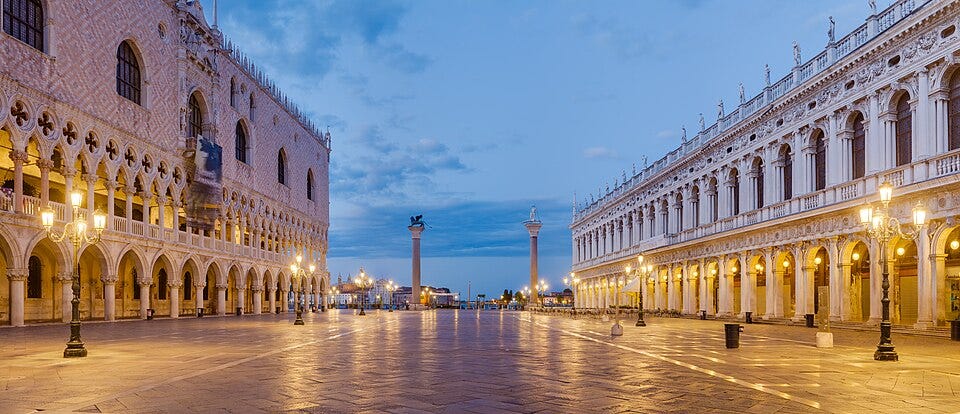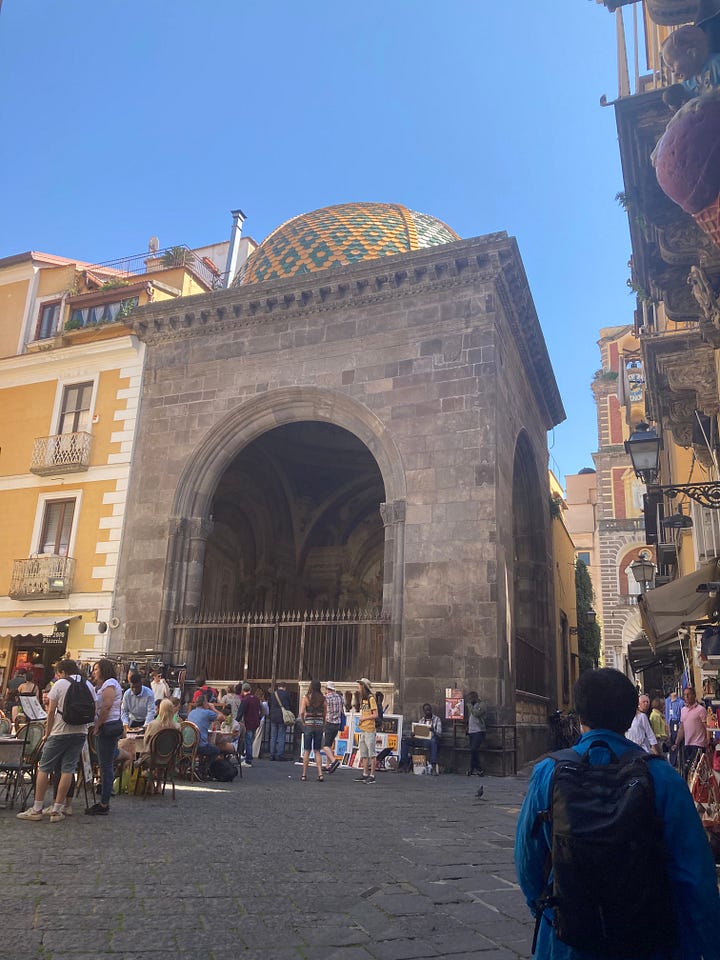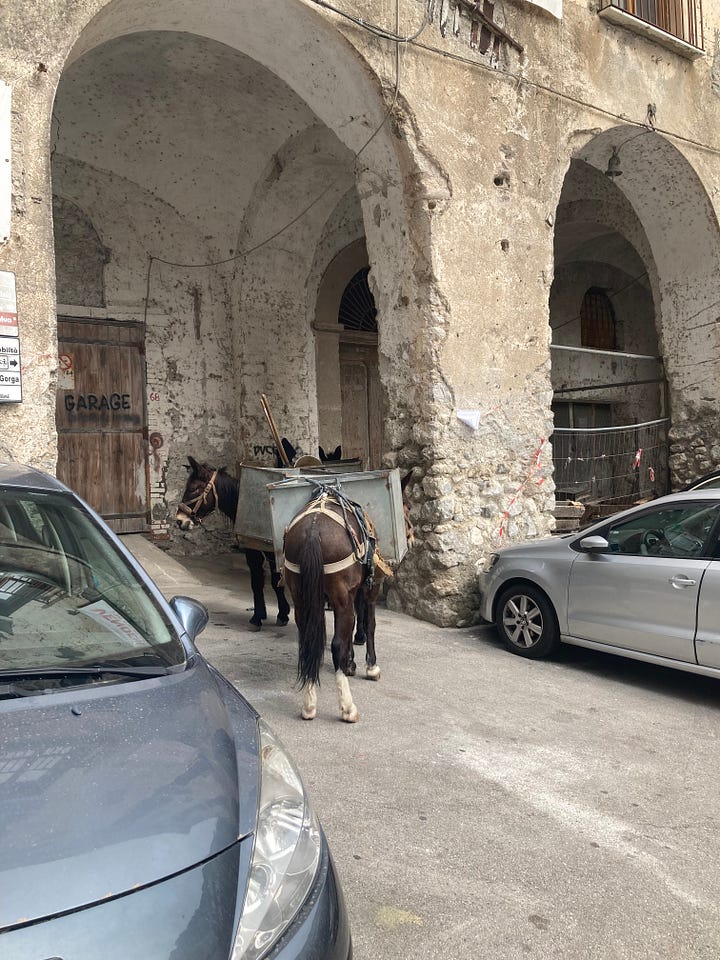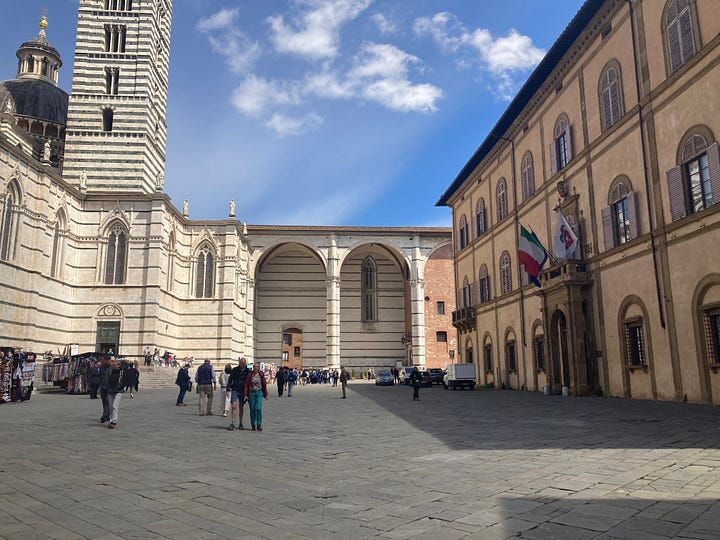Hello, hello!
Happy Friday, grab a coffee and join me, in spirit at least, in northern Italy. I’m here for two weeks with lots to share, about places I love to go and places I’ve never been. And while researching for the trip I read one of those articles that just makes sense of stuff already floating in my head, so I wanted to start there.
Open to the elements
Let’s begin with some architectural terminology: a loggia (pronounced LOH-djee-ya). You may not know the word (though you might), but you’ve probably seen on in real life or in a film. Technically, a loggia is a covered exterior gallery or corridor, open to the elements because its outer wall is only partial. If that doesn’t immediately make you go, ‘oh, a loggia! Why didn’t you say so?’ then think of a corridor on the outside of a building, but instead of windows looking out, it has open arches. If it is on the ground floor, it might look more like a gap in the base of the building, that you enter via arches. But, as they say, a picture is worth a thousand words…

So, that’s a loggia and you can get them in all kinds of buildings and styles of architecture but medieval and early modern Italy really made loggia its own. In fact, I started reading this excellent article about them…
Sexton, Kim, ‘Political Portico: Exhibiting Self-Rule in Early Communal Italy’, The Art Bulletin, 97.3 (2015), pp. 258–78
… and I hadn’t quite gotten my head around the description either. Then there were a few pictures and suddenly I didn’t just know what one was. I knew that I’d seen loads of them and that just looking at them reminded me of being in Italy. Take, for example, from some of my recent pictures:




Loggias can be part of any building but in medieval Italy they were almost a compulsory element of the main public square of towns and cities. Often, they were built into the main government building, as in the case of the doge’s palace in Venice.
Sexton’s article was a deeper dive into why this was and how loggias showcased good government. To get there, though, we need to take a few steps back (as usual).
Loggias were well known in Roman architecture. In practical terms they can add a shady but open and breezy element to a building, helping to provide a cool, shletered spot but they weren’t associated closely with government in Roman Italy. That was a much later development.
Cities and the people who ruled them in medieval Italy (from c. 1100 onwards) were, for good reason, obsessed with good government. What was it? How could it be achieved? What were its obstacles? Remember, this was the world that eventually gave birth to Niccolo Machiavelli, whose famous guide to being a sneaky, ruthless and practical ruler, The Prince, was written in 1513. Whether you think Machiavelli was having a good, ironic laugh at the world around him or was just a bit unpleasant, he was clearly obsessed with how government worked, and didn’t, and he wasn’t alone.
People in medieval Italy were obsessed with good government because they were in the process of experimenting with a fairly innovative way of doing it: the city commune, or republic. There was ancient precedent for cities ruling themselves but in practice, what was happening in Italy was pretty new - an experiment in the making. City councils, elected leaders, selected leaders (often hired from outside for short periods before moving on to their next gig), charismatic aristocrats, trade guilds, bishops and, occasionally, fractious coalitions of any of these plus people disaffected about specific issues or general problems could all play different parts and negotiate their duties and powers, with cities comparing and competing amongst each other.
Whatever their exact local composition, though, these city governments wanted to project some key virtues: transparency, fairness, probity, harmony. And aren’t those all the things you think of when you look at a loggia?
Transparency: no deals done behind closed doors (because no doors!)
Fairness: free access to the space of government to any man who wanted (you can just walk right on in!)
Probity: no bribes because everybody would be able to see you taking them, which isn’t how it’s done, right?
Harmony: everybody hanging out together, having a chat, passing the time of day, talking about how great good government is!
And lest you think that I’m editorialising, Sexton’s article is packed full of examples of people from medieval Italian sources saying exactly this.
The loggia under the main government building shouldn’t be allowed to be cluttered up with crap in storage or unnecessary obstacles because people (all people, i.e. men) should be able to come there and pass the time of day. Maybe some benches would be cool, because then not only can they be harmonious together but they can also demonstrate that harmony to other people (like visitors from other cities, or even just the rest of the population).
The loggia should be a place for doing public business so that people can watch and see how well the government is doing.
Loggias could be simple, low and a bit dingy or high, light and airy. They could be lavishly decorated. (In Florence they eventually got a bit cluttered up with fancy Renaissance statues but the beauty of these city states was that they could each experiment with their own priorities.
Sexton goes further, though. Loggias didn’t just symbolise core values like openness and civic harmony and they didn’t just provide a public (or public-looking) venue for doing government. They also created a way of staging, or presenting government in ways that talked directly to art and vice versa. And, if that, too, sounds a bit vague then, yet again, it is the pictures that do the talking.

If you just look at this image as art, the arches of the loggia make a nice framing device. They add symmetry and set a coherent space for the action. They serve a visual or artistic rather than a structural or architectural purpose. But what if people then started designing or modifying loggias in real life so that when people looked at the action going on in them, it would look like a picture: people would be reminded about the images that celebrated good government or heroic leaders. The image and the physical world would blur, blending ideas and realities.

Or, back to art, what about this painting made in 1338-40 by Ambrogio Lorenzetti and designed for the Palazzo Pubblico in Siena? It is called ‘Effects of Good Government’ and, as Sexton points out, the arches of the loggia here shelter the prosperous tradespeople who are able to flourish under a good government. This isn’t a street scene though: all of the elements are carefully crafted. Under each of the arches, a man plies a different trade. These would all have been practiced in different parts of town. Instead, they are all compressed into the picture together, sheltered by the loggia, to demonstrate how everybody could do well when the state did well. And just as the trades in the picture stand in for the government, by inhabiting the loggia and showing off the calm, peace and prosperity of the community, so too, the viewer, watching government happening in the loggia, might also see the switch work in reverse: the government becomes a stand-in for all of the good, honest, hardworking traders whose lives and interests the government is meant to represent.
We are, for the most part, deeply visual creatures. We see symbols and shapes and we can hold multiple, even competig, meanings. The loggia was a way to exploit that, in art and in architecture: people seeing government could think about art telling them how good that government could be. People seeing art, either about good government or warning about bad government, could map the images onto their own physical space.
Look out for loggias. Apart from anything, it’s a great word to slip casually into conversation. (‘OMG, I just love what you and Steve have done with the loggia!’)
Look out for architecture in art. It’s everywhere, too. Often it is almost invisible, until you notice it. Then simple shapes emerge as powerful symbols, subtly nudging us: because life and art are in a constant state of imitation.






Yes, made me look out for loggias all through our trip! Also, the Greek equivalent for the loggia would be the stoa, usually with columns rather than arches, but serving a similar function I would think—a protected public space for all sorts of activities: political, commercial, artistic. The stoa in Athens had famous pictures and momentos. And of course giving its name to a whole philosophical movement, the Stoics, who happened to get their start in this convenient setting.